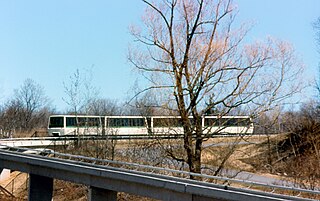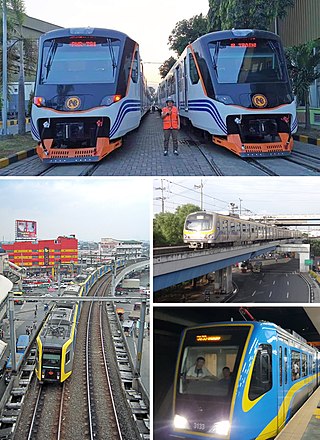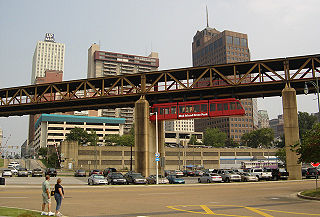
A monorail is a railway in which the track consists of a single rail or a beam.

Personal Rapid Transit (PRT), also referred to as podcars or guided/railed taxis, is a public transport mode featuring small low-capacity automated vehicles operating on a network of specially built guideways. PRT is a type of automated guideway transit (AGT), a class of system which also includes larger vehicles all the way to small subway systems. In terms of routing, it tends towards personal public transport systems.

A people mover or automated people mover (APM) is a type of small scale automated guideway transit system. The term is generally used only to describe systems serving relatively small areas such as airports, downtown districts or theme parks.

An automated guideway transit (AGT) or automated fixed-guideway transit or automatic guideway transit system is a type of fixed guideway transit infrastructure with a riding or suspension track that supports and physically guides one or more driverless vehicles along its length. The vehicles are often rubber tired or steel wheeled, but other traction systems including air cushion, suspended monorail and maglev have been implemented. The guideway provides both physical support, like a road, as well as the guidance.

Innovia Metro is an automated rapid transit system manufactured by Alstom. Innovia Metro systems run on conventional metal rails and pull power from a third rail but are powered by a linear induction motor that provides traction by using magnetic force to pull on a "fourth rail" placed between the running rails. However, newer versions of the technology are available with standard electric rotary propulsion.

An elevated railway or elevated train is a rapid transit railway with the tracks above street level on a viaduct or other elevated structure. The railway may be broad-gauge, standard-gauge or narrow-gauge railway, light rail, monorail, or a suspension railway. Elevated railways are normally found in urban areas where there would otherwise be multiple level crossings. Usually, the tracks of elevated railways that run on steel viaducts can be seen from street level.

The Toronto Zoo Domain Ride was an automated guideway transit (AGT) service used to carry visitors between sections, or "domains", of the Toronto Zoo. Though technologically closer to a simple rubber-tired metro, it was almost universally referred to as a "monorail".

Rail transportation in the Philippines is currently used mostly to transport passengers within Metro Manila and provinces of Laguna and Quezon, as well as a commuter service in the Bicol Region. Freight transport services once operated in the country, but these services were halted. However, there are plans to restore old freight services and build new lines. From a peak of 1,100 kilometers (680 mi), the country currently has a railway footprint of 533.14 kilometers (331.28 mi), of which only 129.85 kilometers (80.69 mi) are operational as of 2023, including all the urban rail lines. World War II, natural calamities, underspending, and neglect have all contributed to the decline of the Philippine railway network. In the 2019 Global Competitiveness Report, the Philippines has the lowest efficiency score among other Asian countries in terms of efficiency of train services, receiving a score of 2.4, and ranking 86th out of 101 countries globally. The government is currently expanding the railway network up to 1,900 kilometers (1,200 mi) by 2022 through numerous projects.

Daegu Metro is a metro system that serves primarily the South Korean city of Daegu, operated by Daegu Metropolitan Transit Corporation from 5:30AM to 0:00AM with the interval from 5 to 8 minutes between each car's arrival. With the fastest track speed at 80 km/h (50 mph), it takes 55 minutes for Line 1 and Line 2, and 48 minutes for Line 3 to reach the terminus station. As of 2015, the number of average daily passengers is 186,992 people for Line 1, 177,984 people for Line 2, and 69,127 people for Line 3.
The Computer-controlled Vehicle System, almost universally referred to as CVS, was a personal rapid transit (PRT) system developed by a Japanese industrial consortium during the 1970s. Like most PRT systems under design at the same time, CVS was based around a small four-person electric vehicle similar to a small minivan that could be requested on demand and drive directly to the user's destination. Unlike other PRT systems, however, CVS also offered cargo vehicles, included "dual-use" designs that could be manually driven off the PRT network, and included the ability to stop at intersections in a conventional road-like network.
Krauss-Maffei's Transurban was a 12-passenger automated guideway transit (AGT) mass transit system based on a maglev guideway. Development started in 1970 as one of the many AGT and PRT projects that followed in the wake of the HUD reports of 1968. Its selection as the basis of the GO-Urban system in Toronto in 1973 made it well known in the industry; it would have been the basis of the first large-area AGT mass transit network in the world. Technical problems cropped up during the construction of the test track, and the sudden removal of funding by the West German government led to the project's cancellation in late 1974. The Ontario government completed development and installation of a non-maglev version, today known as the Bombardier Advanced Rapid Transit.
GO-Urban was a planned mass transit project for Greater Toronto to be operated by GO Transit. The system envisioned the use of automated guideway transit vehicles set up in hydro corridors and other unused parcels of land to provide rapid transit services without the expense of constructing tunnels. GO-Urban would serve high-density areas in the downtown core, but also be able to accelerate to high speed between distant stations in the outskirts of the city. Similar deployments were planned for Hamilton and Ottawa.

The Dashaveyor was an automated guideway transit (AGT) system developed during the 1960s and '70s.

A suspension railway is a form of elevated monorail in which the vehicle is suspended from a fixed track, which is built above streets, waterways, or existing railway track.

The Bicutan AGT is an automated guideway transit (AGT) system under development as of 2020 within the City of Taguig in the Philippines. It will serve as test track for the second mass transit system to be built and developed in the country by local engineers.
The Metro Rail Transit Line 4, also known as MRT Line 4, is an approved mass rapid transit line to be built in Metro Manila and Rizal in the Philippines.
The Philippine government has commenced a project to develop a locally designed and manufactured Automated Guideway Transit System (AGTS) through its Department of Science and Technology (DOST). Two prototype lines has been set up by the DOST, one within the University of the Philippines Diliman campus and another in Bicutan in Taguig.

The Hybrid Electric Train (HET) is a hybrid electric train built by the Department of Science and Technology's Metals Industry Research and Development Center.

The Gatwick Airport Shuttle Transit is a 0.75-mile (1.21 km) long elevated automated people mover that links the North and South Terminals at London's Gatwick Airport. The line is ground-side, and besides linking the two terminals also serves to link the North terminal to the airport railway station. Although sometimes colloquially, but erroneously, known as a "monorail", the transit vehicles are carried on rubber tyres running on a concrete track with twin running surfaces and are steered by separate guide rails.
The Cebu Monorail Transit System, simply known as the Cebu Monorail, is a proposed monorail rapid transit system to be built in Metro Cebu, Philippines. Originally proposed by the Japanese in 2015 as the Cebu MRT System, it was revised to a light rail line in the late 2010s, dubbed the Cebu Light Rail Transit System or Cebu LRT. It was then again revised to its present form in late 2019.













